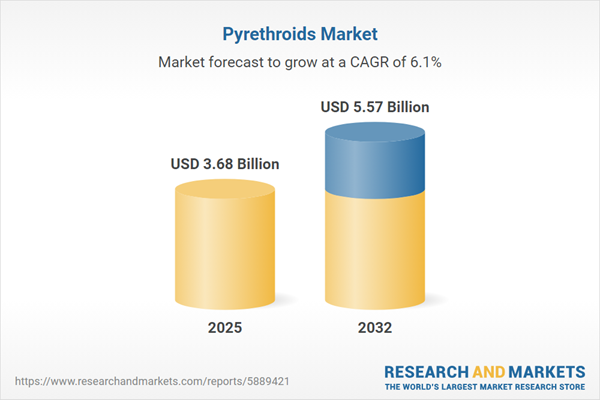Speak directly to the analyst to clarify any post sales queries you may have.
Senior leaders in pest control and agricultural industries rely on up-to-date market insight to respond effectively to regulatory shifts, technology evolution, and changing operational priorities. This report on the pyrethroids market delivers focused intelligence tailored for leadership teams facing complex global and local challenges.
Pyrethroids Market Snapshot: Structured Expansion and Evolving Demand
The pyrethroids market is experiencing robust and consistent growth, driven by sustained demand across agriculture and urban pest management applications. As of 2024, the global market has reached USD 3.46 billion, with expectations to rise to USD 3.68 billion by 2025 and to an estimated USD 5.57 billion by 2032. This development underscores a compound annual growth rate of 6.10%. Key factors propelling momentum include advancements in active ingredient development, the introduction of improved delivery systems, and ongoing enhancements in application efficiency. Increasing adoption extends beyond traditional agricultural use into areas related to food sector operations, public health, and property care, reflecting the broader acceptance of integrated pest management practices aligned with compliance imperatives.
Scope & Segmentation: Relevant Segments and Global Reach
- Application Areas: Pyrethroids are utilized in multiple segments, including crop protection, rice and vegetable farming, urban pest and vector control, horticultural operations, public health services, hospitality, logistics, institutional and commercial facilities, and outdoor event venues. Each target area reflects growing priorities around food safety, health standards, and building management.
- Active Ingredients: Segmentation includes cypermethrin, deltamethrin, fenvalerate, and permethrin. These components are chosen for site-specific resistance needs and regional regulatory requirements, ensuring organizations maintain compliance and efficacy.
- Formulation Types: Pyrethroids are available in formats such as dustable powders, emulsifiable concentrates, suspension concentrates, and water dispersible granules. Diverse formulations support operational flexibility and allow customization to varying application circumstances and standards.
- Pyrethroid Types: Both Type I and Type II categories are broadly used. The selection enables flexible management of resistance profiles and alignment with evolving international and regional compliance mandates.
- Delivery Modes: Distribution options include aerial application via aircraft and helicopters, manual deployment with backpack and handheld sprayers, and coverage with tractor-mounted systems. These methods accommodate both large-scale land coverage and targeted site applications, supporting operational efficiency.
- Regional Coverage: The market is structured globally, encompassing North America, Latin America, Europe, the Middle East, Africa, and Asia-Pacific. Countries such as the United States, China, Brazil, Germany, India, and Australia serve as focal areas, each presenting unique operational, compliance, and climate variables affecting industry dynamics.
- Key Players: Market direction is shaped by organizations including BASF SE, Bayer AG, FMC Corporation, Corteva Agriscience LLC, Sumitomo Chemical, Syngenta AG, Nufarm Limited, Rotam Agrochemical, Jiangsu Yangnong Chemical, and Shandong Rainbow Chemical. These entities influence regulatory trajectory, innovation, and supply dynamics across the sector.
Key Takeaways for Senior Decision-Makers
- Organizations deploying pyrethroid-based control solutions are well-positioned to respond to shifting pest threats and strengthen stability across supply chains involved in agriculture, property, and related areas.
- Diversification into commercial and hospitality sectors highlights the need for adaptable pest management protocols that account for localized regulatory and functional requirements.
- Emerging technologies, such as microencapsulation and precision application tools, assist organizations in mitigating environmental impacts while aligning with heightened regulatory standards globally.
- Adoption of digital monitoring and integrated analytics is advancing resistance management, supporting proactive and data-driven decisions for compliance and operations.
- Strategic selection of ingredients and formulation types allows companies to efficiently adapt to different pest management mandates, supporting quicker responses amid shifting policy or pest environments.
- Cross-regional partnerships in the supply chain are increasingly vital for maintaining secured access to essential raw materials and anticipating future regulatory changes that may influence input sourcing.
Tariff Impact: Navigating Regulatory and Trade Shifts
Recent alterations in U.S. tariffs have led organizations to reevaluate and restructure supply networks. Increased emphasis on regional and local sourcing, as well as deeper supplier collaboration, is helping businesses ensure ongoing availability of critical pest management resources, regardless of broader trade fluctuations.
Methodology & Data Sources
This report is built on comprehensive secondary research, in-depth regulatory analysis, and direct insights from leading professionals within the agricultural and chemical sectors. The combined methodology delivers reliable, actionable information for strategic decision-making.
Why This Report Matters: Actionable Pyrethroids Market Intelligence
- Obtain a clear view of pyrethroids market trends, changing regulations, and advancement in pest management technology to support robust planning and compliance strategies.
- Equip procurement and compliance teams to act based on current intelligence specific to regions and application sectors, enhancing operational alignment and effectiveness.
- Support seamless integration of pest management approaches into risk frameworks, providing greater sustainability and resilience for future scenarios.
Conclusion
Consistent, targeted insights into the pyrethroids market enable leaders to anticipate operational and regulatory developments. Staying informed provides the necessary foundation for sustainable, responsive, and forward-focused decision-making in a changing global environment.
Additional Product Information:
- Purchase of this report includes 1 year online access with quarterly updates.
- This report can be updated on request. Please contact our Customer Experience team using the Ask a Question widget on our website.
Table of Contents
3. Executive Summary
4. Market Overview
7. Cumulative Impact of Artificial Intelligence 2025
Companies Mentioned
The companies profiled in this Pyrethroids market report include:- BASF SE
- Bayer AG
- FMC Corporation
- Corteva Agriscience LLC
- Sumitomo Chemical Co., Ltd.
- Syngenta AG
- Nufarm Limited
- Rotam Agrochemical Co., Ltd.
- Jiangsu Yangnong Chemical Group Co., Ltd.
- Shandong Rainbow Chemical Co., Ltd.
Table Information
| Report Attribute | Details |
|---|---|
| No. of Pages | 186 |
| Published | November 2025 |
| Forecast Period | 2025 - 2032 |
| Estimated Market Value ( USD | $ 3.68 Billion |
| Forecasted Market Value ( USD | $ 5.57 Billion |
| Compound Annual Growth Rate | 6.1% |
| Regions Covered | Global |
| No. of Companies Mentioned | 11 |









